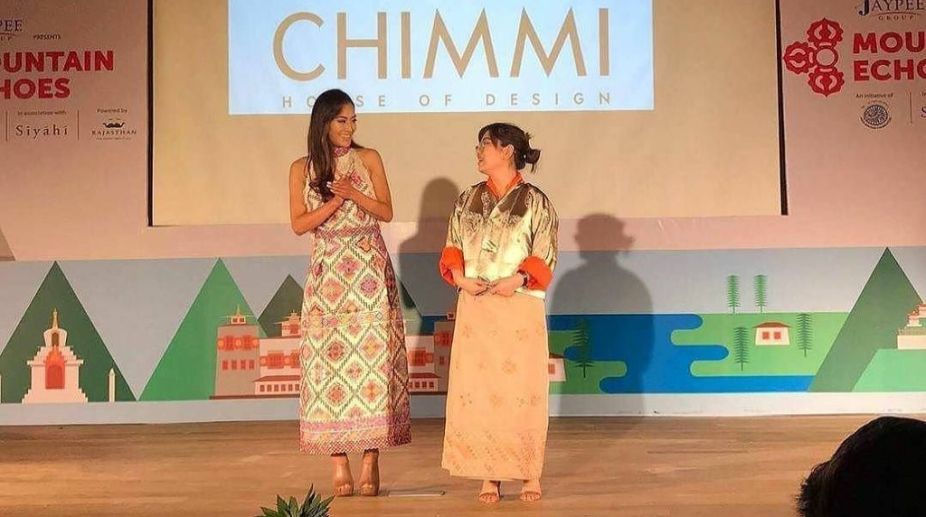ILPA announces Leather Fashion Xtravaganza 2024
Leather Fashion Xtavaganza 2024 will showcase the growth and development of leather industry in Bengal and India. It will be organised by Indian Leather Products Association.

(Photo: Twitter)
The eighth edition of the distinctive literary, arts and culture in Bhutan’s national capital, Thimphu celebrates the “Untouched Beauty, Unexplored Ideas and Unstoppable Voices” from the heart of the happiest country in the world.
Fashion, is one of the key themes for this year’s Mountain Echoes Literary Festival that brings together wellknown designers from across India and Bhutan. With an aim to build a common thread between the two countries and their shared culture, they join hands to curate collections which intersperse the textile traditions with contemporary style. Designers Chandrika Tamang and Chimmi Choden, and Pramod Kumar KG, festival co-director; talk about the fashion element, the global evolution of textiles, design traditions, and a deeper insight into the literature, arts and philosophy.
Excerpts:
Advertisement
Q Could you describe the fashion scene in Bhutan?
Choden: There is a huge creative burst happening in the country right now and this field has made a huge leap to the global stage like our film industry, fashion and music. Fashion in Bhutan will definitely be booming in the coming years with its unique identity. In fact, you can see the influence of Indian design all over on the streets of Thimphu.
Tamang: In Bhutan, we have different fashion for different ages. Youngsters get influence from Korean fashion, older people get going with comfort clothing and well-constructed styles, the rest follow and mix those two fashions. Q How has your work evolved over the years? Tamang: My designs and techniques have both evolved. I get inspiration from our national dress and try to give it a modern look using different fabrics, techniques and patterns.
Choden: Being a designer is a constant journey of change. The brand has grown so fast and we are constantly being invited to new events across the world. At the beginning, I said “yes” to every offer that came my way, but I’ve learned how to balance now.
Q Are there any types of clothing that you avoid wearing?
Choden: If I feel I cannot carry it off or something that doesn’t suit my physique, I try to avoid. Tamang: Once I learnt about the pollution that cloth makes, I have been trying to avoid nylons and synthetics at least.
Q How would you describe your design?
Choden: All our designs are brought to life by four master weavers, who have developed their craft over a lifetime on-the loom training. It is built upon traditional techniques to create new motifs and designs, and experiment with various fibres, patterns, and colour combinations that give a more contemporary vibe. The designs and construction of the garments transform traditional art work into relevant, wearable, one-of-a-kind pieces.
Tamang: I often buy raw silk from Assam and dye and mix it with hand-woven Bhutanese textile fabric. I have been inspired by Indian tie dye techniques and block printings and have been using turmeric, tea leaves, madder, gold marry leaves, purple cabbage, bit roots and flowers to dye the yarn or fabric.
Q What are your special collections for the festival?
Choden: We will showcase a fusion of Indian handloom Khadi with Bhutanese textiles woven on a traditional backstrap loom. The garments are inspired by traditional Bhutanese dress. We’re using our traditional patterns on the textiles, but the cuts and construction are modern and wearable.
Tamang: The collection has 10 dresses, out of which the first five are inspired by the bright colours of the Buddhist flag. We use hand woven textile and silk on cotton and get its name from the five elements. Each dress is designed according to the significance of the elements. Additionally, the fading colour of the flags is considered auspicious so the other dresses in my collection will have light colours dyed naturally in raw silk.
Q Is there any prospect of an expansion of Indo-Bhutan couture that will hold your signature? There are plans for expansion in the near future. We would love to bring our work with Indian garments with Bhutanese textile or vice versa and make a contemporary collection.
Q What can one look forward to at the eighth edition of the Mountain Echoes Festival?
Pramod Kumar: With each edition, we aim to present a deeper insight into the literature, arts and philosophy of Bhutan and India. The discussion and discourse inspire both local and global audiences through a diverse range of topics. We try to give momentum that are reflective of global populations and continue to explore relevant issues. We have used India and Bhutan’s heritage of hand weaving and textiles to build a common thread and their shared cultures.
We have received tremendous positive feedback for each of the past editions as there’s something for everyone. We are certain that our idyllic location, powerful programme and eminent speakers will leave audiences engaged and enriched.
Advertisement